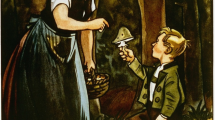Abstract
This essay examines Eleanor Estes's critically neglected 1960 novel The Witch Family, arguing that the novel anticipates some of the major preoccupations of later children’s literature in its early concern with issues of textuality. While Estes is largely known as a writer of simple family stories, The Witch Family is an innovative work of metafiction, which explicitly engages with a number of philosophical and literary-critical issues central to postmodern and poststructuralist discussion. Posing central and overt questions regarding the relationship between reality and fiction, the novel illustrates the contextual, communal, and relational aspects of language and finally suggests that the ability to tell stories ethically is tied to the recognition of one’s own contingent position within language.
Similar content being viewed by others
References
Cashore, Kristin. (2003). Humor, Simplicity, and Experimentation in the Picture Books of Jon Agee. Children’s Literature in Education, 34(2), 147–181.
De Certeau, Michel. (1984). The Practice of Everyday Life Berkeley: University of California Press.
Didicher, Nicole E. (1997). The Children in the Story: Metafiction in Mary Poppins in the Park. Children’s Literature in Education, 28(3), 137–149.
Estes, Eleanor. (1960). The Witch Family. New York: Harcourt, Brace and World, Inc.
Estes, Eleanor. (1987). The Curious Adventures of Jimmy McGee. Orlando: Harcourt, Inc.
La Belle, Jenijoy. (1988). Herself Beheld: The Literature of the Looking Glass Ithaca: Cornell University Press.
McCallum, Robyn. (1999). Very Advanced Texts: Metafictions and Experimental Work. In Peter Hunt (Ed.), Understanding Children’s Literature (pp. 138–150). New York: Routledge.
Mills, Claudia. (2002). Artistic and Moral Imagination in The Hundred Dresses by Eleanor Estes. Children’s Literature in Education, 35(3), 167–174.
Moss, Anita. (1985). Varieties of Children’s Metafiction. Studies in Literary Imagination, 17(2), 79–92.
Nelson, Claudia. (2006). Writing the Reader: The Literary Child in and Beyond the Book. Children’s Literature Association Quarterly, 31(3), 222–238.
Nikolajeva, Maria. (1995). Children’s Literature as Cultural Code: A Semiotic Approach to History. In Maria Nikolajeva (Ed.), Aspects and Issues in the History of Children’s Literature (pp. 39–48). Westport, Conn: Greenwood Publishing.
Nikolajeva, Maria. (1998). Exit Children’s Literature. The Lion and the Unicorn, 22(2), 221–236.
Pantaleo, Sylvia. (2006). “Postmodernism, Metafiction and Who’s Afraid of the Big Bad Wolf? The Journal of Children’s Literature Studies., 3(2), 26–39.
Russell, David L. (1989). Stability and Change in the Family Saga: Eleanor Estes’ Moffat Series. Children’s Literature Association Quarterly, 14(3), 171–174.
Trites, Roberta Seelinger. (1997). Waking Sleeping Beauty: Feminist Voices in Children’s Novels Iowa City: University of Iowa Press.
Wolf, Virginia. L. (1983). Eleanor Estes. In John Cech (Ed.), American Writers for Children, 1900–1960. Vol 22 of Dictionary of Literary Biography (pp. 146–156) Detroit: Gale Research Company.
Author information
Authors and Affiliations
Corresponding author
Additional information
Dawn Heinecken is Associate Professor of Women’s and Gender Studies at the University of Louisville and is the author of The Warrior Women of Television: A Feminist Cultural Analysis of the New Female Body in Popular Media and, with Vickie Shields, a co-writer of Measuring Up: How Advertising Affects Self-Image, which won the 2004 National Communication Association’s award for Outstanding Research in Visual Communication. Her other publications focus on critical cultural analysis of gender and body image representations in popular culture, including professional wrestling, romance novels, fan fiction, as well as the marketing of “adult home novelty” products to women.
Rights and permissions
About this article
Cite this article
Heinecken, D. The Reality of Fiction and the Ethics of Storytelling in Eleanor Estes's The Witch Family . Child Lit Educ 41, 260–272 (2010). https://doi.org/10.1007/s10583-010-9108-x
Published:
Issue Date:
DOI: https://doi.org/10.1007/s10583-010-9108-x




